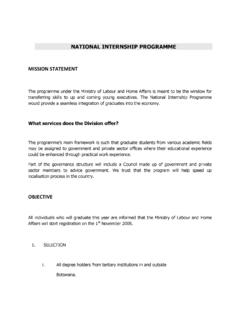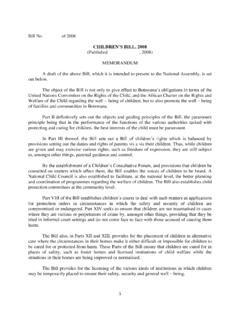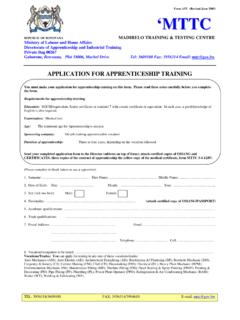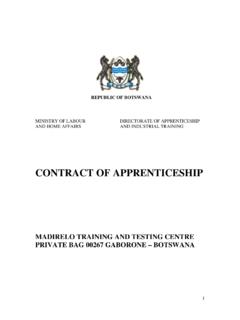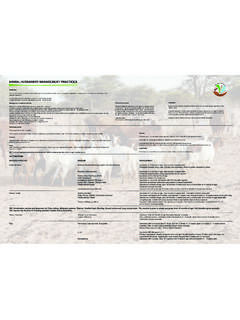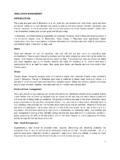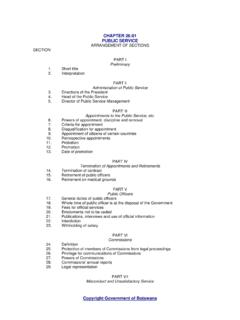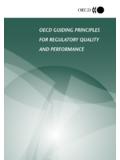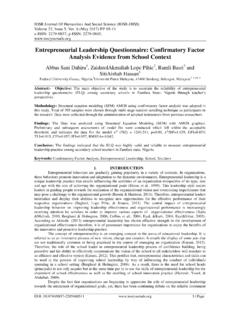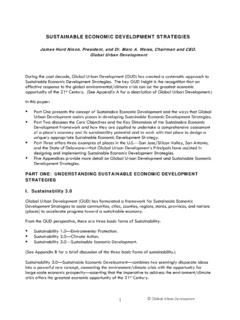Transcription of Poverty Eradication - Botswana
1 Poverty EradicationGuidelines Implementation of Packages2012 Republic of BotswanaContacts: Office of the President: 3950805 Ministry of Agriculture: 3689339 Ministry of Labour and Home Affairs: 3912290 Ministry of Local Government: 3971916 Copyright, Government of Botswana Poverty Eradication Guidelines Ist Issue 2012iIt is now 45 years since Botswana attained independence. At the time of Independence, Botswana was classified as one of the ten poorest countries in the world, and is now classified as one of the middle income countries. We have also over the years managed to reduce the level of Poverty in the country. Statistics show that people in the country living below the Poverty datum line have reduced from 59 percent in 1985/86 to 30 percent in 2002/03.
2 Based on the statistics of 2010/11 statistics, percent of people are living below the Poverty datum line. In his Inaugural Address of 2009, His Excellency the President of Botswana identified Poverty Eradication as one of his Flagship Programmes. The coordination of Poverty Eradication is now in the Office of the President headed by me and assisted by the Minister for Presidential Affairs and Public Administration, Hon. Masisi. Following the successful launch of the Poverty Eradication roadmap during the Pitso in Mahalapye, more consultation have been held with the nation through regional Dipitso, kgotla meetings, full council meetings, radio and television talk shows. At the same time phase one on the roll out of the Poverty Eradication Programme was accelerated.
3 Data synthesised from the consultations and from practice has culminated in these guidelines which I deem as timely and appropriate. The objectives of launching the guidelines are to: Aid all stakeholders to understand the underlying principles of the Poverty Eradication programme; Ensure that there is a common platform for implementers across the country; Provide valuable information to the beneficiaries for them to make informed decisions in selection and management of the projects; Provide valuable knowledge transfer to the rest of the nation which they can use to kick start their own projects at various scales; and Ensure that the core principles of transparency and objectivity are inbuilt into the programme. Owing to the dynamic environment and the underlying principle of continuous improvement within which the Poverty Eradication Progamme operates, I expect these guidelines to be updated every two Honour the Vice President of BotswanaLt.
4 Gen. Mompati Sebogodi MerafheForewordiiGovernance of the Poverty Eradication ProgrammeSetting up effective governance structures is imperative owing to the fact that they are the key to efficient, effective, and efficacious development, implementation, review, and continuous improvement of the Poverty Eradication Programme. It also enables all stakeholders to know how to contribute to the initiative, access information, and seek aid. It is owing to this that I hereby briefly state the governance structures of the head of the Poverty Eradication Programme is His Honour the Vice President, Lt. Gen. Merafhe, assisted by myself, the Honorable Minister for Presidential Affairs and Public Administration. We report to His Excellency the President every two months on progress during the Special Cabinet Meetings.
5 I also chair the Poverty Eradication Cabinet Subcommittee which meets ones a month and is comprised of the following: Assistant Minister of Finance and Development Planning, Hon. G. Somolekae, Assistant Minister of Local Government, Hon. B. Tshireletso; Assistant Minister of Trade and Industry, Honourable Seretse; Assistant Minister of Education, Honourable K. Rakhudu; and Assistant Minister of Agriculture, Honourable O. our work is the Poverty Eradication Task Team comprised of professionals from implementing ministries which meets once a week and is chaired by the Permanent Secretary for Poverty Eradication . The technical work done by the task team, through the support of the Poverty Eradication Unit at the Office of the President, is vetted by the above structures and is used to direct operations of implementing ministries.
6 The Department of Social Services through its social workers is the key access point to all those who seek information about the programme or are interested in any of the Poverty Eradication projects. As His Honour the Vice President and I always say, our doors are open to anyone who wants to positively contribute to the Eradication of Poverty . Poverty Eradication is a challenge we can conquer if we are united in effort as Botswana and our development for Presidential Affairs and Public AdministrationHonourable Masisi1 Table Of Contents1. BACKGROUND 6 2.
7 OBJECTIVES OF THE IMPLEMENTATION GUIDELINES 63. EXPECTED OUTCOMES 74. COMPONENTS OF THE PROGRAMME The Packages Financial Models Group Projects 85. ELIGIBILITY CRITERIA 86. SKILLS TRANSFER 97. PROGRAMME IMPLEMENTATION 98. ISSUES FOR CONSIDERATION IN IMPLEMENTING THE PACAKAGES Community Mobilization Needs Profiling Identification of the Project Training Development of a Project Plan Resource Mobilisation Marketing Gender People with Disability Psychosocial Support
8 Confidentiality 119. MONITORING AND EVALUATION 1210. REVIEW OF THE GUIDELINES 1211. ANNEXURES 122 Acronyms and Abbreviations MOESD - Ministry of Education and Skills Development MLG - Ministry of Local GovernmentMLHA - Ministry of Labour and Home AffairsMoA - Ministry of Agriculture MEWT - Ministry of Environment, Wildlife and Tourism MTI: Ministry of Trade & Industry: DIA - Department of Industrial Affairs DTCA - Department of Trade & Consumer Affairs DoCD - Department of Cooperative DevelopmentDETs - District Extension Teams.
9 CBOs - Community Based Organizations NGOs - Non Government Organizations FBOs - Faith Based Organizations MOA - Memorandum of Agreement BOBS - Botswana Bureau of Standards RADP - Remote Area Development Programme BNYC - Botswana National Youth CouncilDPEC - District Poverty Eradication Committee LEA - Local Enterprise - Citizen Entrepreneurial Development AgencyLIMID - Livestock Management and Infrastructure Development OP - Office of the PresidentWAD - Women's Affairs DepartmentDET - District Extension TeamDSS - Department of Social servicesM&E - Monitoring and EvaluationS&CD - Social and Community DevelopmentSSN - Social Safety NetVDC - Village Development Committee3 LEGAL framework guiding THE Poverty Eradication INITIATIVEThe Poverty Eradication Initiative operates within an environment where there are legal instruments, acts and policies implemented as a matter of control of various small businesses.
10 The expectation is that businesses set up under the Poverty Eradication Programme operate within the current legal framework . Table 1 outlines policies, Acts and guidelines that have informed the preparation of these guidelines. The list is not 1: Policies, Acts and GuidelinesPolicy/Act/GuidelineImplemente d ByResponsible Officers1. Guidelines for registration of micro and small businesses exempt from licensing requirements, March 2011 SMMEs Policy 1999, Industrial Development Act 2006 Trade Act 2003 MTI Through all District CouncilsCommercial officers in Councils Department of Industrial Affairs and Department of Trade and Consumer Affairs} MTI2. Local Authorities Procurement and Asset Disposal Act 2008 MLG and District CouncilsCouncil Secretaries/Adjudication Secretaries3.
